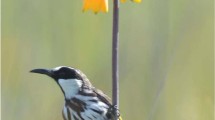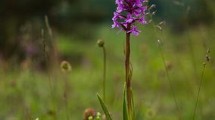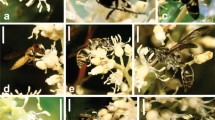Abstract
The evolution of floral traits may be shaped by a community of floral visitors that affect plant fitness, including pollinators and floral antagonists. The role of nectar in attracting pollinators has been extensively studied, but its effects on floral antagonists are less understood. Furthermore, the composition of non-sugar nectar components, such as secondary compounds, may affect plant reproduction via changes in both pollinator and floral antagonist behavior. We manipulated the nectar alkaloid gelsemine in wild plants of the native perennial vine Gelsemium sempervirens. We crossed nectar gelsemine manipulations with a hand-pollination treatment, allowing us to determine the effect of both the trait and the interaction on plant female reproduction. We measured pollen deposition, pollen removal, and nectar robbing to assess whether gelsemine altered the behavior of mutualists and antagonists. High nectar gelsemine reduced conspecific pollen receipt by nearly half and also reduced the proportion of conspecific pollen grains received, but had no effect on nectar robbing. Although high nectar gelsemine reduced pollen removal, an estimate of male reproduction, by one-third, this effect was not statistically significant. Fruit set was limited by pollen receipt. However, this effect varied across sites such that the sites that were most pollen-limited were also the sites where nectar alkaloids had the least effect on pollen receipt, resulting in no significant effect of nectar alkaloids on fruit set. Finally, high nectar gelsemine significantly reduced seed weight; however, this effect was mediated by a mechanism other than pollen limitation. Taken together, our work suggests that nectar alkaloids are more costly than beneficial in our system, and that relatively small-scale spatial variation in trait effects and interactions could determine the selective impacts of traits such as nectar composition.



Similar content being viewed by others
References
Adler LS (2000) The ecological significance of toxic nectar. Oikos 91:409–420
Adler LS (2007) Selection by pollinators and herbivores on attraction and defense. In: Tilmon KJ (ed) Specialization, speciation, and radiation: the evolutionary biology of herbivorous insects. University of California Press, Berkeley, pp 162–173
Adler LS, Bronstein JL (2004) Attracting antagonists: does floral nectar increase leaf herbivory? Ecology 85:1519–1526
Adler LS, Irwin RE (2005) Ecological costs and benefits of defenses in nectar. Ecology 86:2968–2978
Agrawal AA, Conner JK, Rasmann S (2010) Tradeoffs and negative correlations in evolutionary ecology. In: Bell MA, Futuyma DJ, Eanes WF, Levinton JS (eds) Evolution since Darwin: the first 150 years. Sinauer, Sunderland, pp 243–268
Alexander HM (2010) Disease in natural plant populations, communities, and ecosystems: insights into ecological and evolutionary processes. Plant Dis 94:492–503
Ashman TL, Knight TM, Steets JA, Amarasekare P, Burd M, Campbell DR, Dudash MR, Johnston MO, Mazer SJ, Mitchell RJ, Morgan MT, Wilson WG (2004) Pollen limitation of plant reproduction: ecological and evolutionary causes and consequences. Ecology 85:2408–2421
Baker HG, Baker I (1975) Studies of nectar-constitution and pollinator-plant coevolution. In: Gilbert LE, Raven PH (eds) Coevolution of plants and animals. University of Texas Press, Austin, pp 100–140
Baker HG, Baker I (1978) Ants and flowers. Biotropica 10:80
Bolstad GH, Armbruster WS, Pelabon C, Perez-Barrales R, Hansen TF (2010) Direct selection at the blossom level on floral reward by pollinators in a natural population of Dalechampia schottii: full-disclosure honesty? New Phytol 188:370–384
Brody AK, Zimmerman M (1995) The effects of pre-dispersal seed predators and pollinators on the flowering phenology of two co-occurring plants. Bull Ecol Soc Am 76:31
Burd M (1994) Bateman’s principle and plant reproduction: the role of pollen limitation in fruit and seed set. Bot Rev 60:83–139
Burnside CE, Vansell GH (1936) Plant poisoning of bees. E-398, United States Department of Agriculture, Bureau of Entomology and Plant Quarantine, Washington, DC
Campbell DR (2009) Using phenotypic manipulations to study multivariate selection of floral trait associations. Ann Bot 103:1557–1566
Carter C, Thornburg RW (2004) Is the nectar redox cycle a floral defense against microbial attack? Trends Plant Sci 9:320–324
Darwin C (1877) The different forms of flowers on plants of the same species. John Murray, London
De Moraes CM, Mescher MC, Tumlinson JH (2001) Caterpillar-induced nocturnal plant volatiles repel nonspecific females. Nature 410:577–580
Eckert JE (1946) Injury to bees by poisoning. In: Grout RA (ed) The hive and the honey bee. Dadant, Hamilton, pp 570–582
Fishman L, Willis JH (2008) Pollen limitation and natural selection on floral characters in the yellow monkeyflower, Mimulus guttatus. New Phytol 177:802–810
Fishman L, Wyatt R (1999) Pollinator-mediated competition, reproductive character displacement, and the evolution of selfing in Arenaria uniflora (Caryophyllaceae). Evolution 53:1723–1733
Gegear RJ, Manson JS, Thomson JD (2007) Ecological context influences pollinator deterrence by alkaloids in floral nectar. Ecol Lett 10:375–382
Gomez JM, Perfectti F, Bosch J, Camacho JPM (2009) A geographic selection mosaic in a generalized plant-pollinator-herbivore system. Ecol Monogr 79:245–263
Hardin JW, Arena JM (1969) Human poisoning from native and cultivated plants. Duke University Press, Durham
Irwin RE, Adler LS (2006) Correlations among traits associated with herbivore resistance and pollination: implications for pollination and nectar robbing in a distylous plant. Am J Bot 93:64–72
Irwin RE, Brody AK, Waser NM (2001) The impact of floral larceny on individuals, populations, and communities. Oecologia 129:161–168
Janzen DH (1977) Why don’t ants visit flowers? Biotropica 9:252
Johnson SD, Hargreaves AL, Brown M (2006) Dark, bitter-tasting nectar functions as a filter of flower visitors in a bird-pollinated plant. Ecology 87:2709–2716
Kearns CA, Inouye DW (1993) Techniques for pollination biologists. University Press of Colorado, Niwot
Kessler A, Baldwin IT (2004) Herbivore-induced plant vaccination. Part I. The orchestration of plant defenses in nature and their fitness consequences in the wild tobacco Nicotiana attenuata. Plant J 38:639–649
Kessler D, Baldwin IT (2007) Making sense of nectar scents: the effects of nectar secondary metabolites on floral visitors of Nicotiana attenuata. Plant J 49:840–854
Kessler D, Gase K, Baldwin IT (2008) Field experiments with transformed plants reveal the sense of floral scents. Science 321:1200–1202
Kingsbury JM (1964) Poisonous plants of the United States and Canada. Prentice-Hall, Englewood Cliffs
Knight TM, Steets JA, Vamosi JC, Mazer SJ, Burd M, Campbell DR, Dudash MR, Johnston MO, Mitchell RJ, Ashman TL (2005) Pollen limitation of plant reproduction: pattern and process. Annu Rev Ecol Evol Syst 36:467–497
Knight TM, Steets JA, Ashman TL (2006) A quantitative synthesis of pollen supplementation experiments highlights the contribution of resource reallocation to estimates of pollen limitation. Am J Bot 93:271–277
Lankau RA, Strauss SY (2008) Community complexity drives patterns of natural selection on a chemical defense of Brassica nigra. Am Nat 171:150–161
Lloyd DG, Barrett SCH (eds) (1996) Floral biology: studies on floral evolution in animal-pollinated plants. Chapman and Hall, New York
Manson JS, Thomson JD (2009) Post-ingestive effects of nectar alkaloids depend on dominance status of bumblebees. Ecol Entomol 34:421–426
McCall AC, Irwin RE (2006) Florivory: the intersection of pollination and herbivory. Ecol Lett 9:1351–1365
Nicolson S (2007) Nectar consumers. In: Nicolson S, Nepi M, Pacini E (eds) Nectaries and nectar. Springer, Dordrecht, pp 289–342
Nicolson SW, Nepi M, Pacini E (eds) (2007) Nectaries and nectar. Springer, Dordrecht
Ornduff R (1970) Systematics and breeding system of Gelsemium (Loganiaceae). J Arnold Arboretum 51:1–17
Ornduff R (1979) Features of pollen flow in Gelsemium sempervirens (Loganiaceae). J Arnold Arboretum 60:377–381
Parachnowitsch AL, Kessler A (2010) Pollinators exert natural selection on flower size and floral display in Penstemon digitalis. New Phytol 188:393–402
Phillips HR (1985) Growing and propagating wild flowers. University of North Carolina Press, Chapel Hill
Power ME, Dietrich WE, Sullivan KO (1998) Experimentation, observation, and inference in river and watershed investigations. In: Resetarits WJJ, Bernardo J (eds) Experimental ecology: issues and perspectives. Oxford University Press, New York, pp 113–132
Price MV, Waser NM, Irwin RE, Campbell DR, Brody AK (2005) Temporal and spatial variation in pollination of a montane herb: a seven-year study. Ecology 86:2106–2116
Rhoades DF, Bergdahl JC (1981) Adaptive significance of toxic nectar. Am Nat 117:798–803
Roy BA (1996) A plant pathogen influences pollinator behavior and may influence reproduction of nonhosts. Ecology 77:2445–2457
Sasu MA, Seidl-Adams I, Wall K, Winsor JA, Stephenson AG (2010a) Floral transmission of Erwinia tracheiphila by cucumber beetles in a wild Cucurbita pepo. Environ Entomol 39:140–148
Sasu MA, Wall KL, Stephenson AG (2010b) Antimicrobial nectar inhibits a florally transmitted pathogen of a wild Cucurbita pepo (Cucurbitaceae). Am J Bot 97:1025–1030
Sletvold N, Grindeland JM, Agren J (2010) Pollinator-mediated selection on floral display, spur length and flowering phenology in the deceptive orchid Dactylorhiza lapponica. New Phytol 188:385–392
Stanton M, Young HJ, Ellstrand NC, Clegg JM (1991) Consequences of floral variation for male and female reproduction in experimental populations of wild radish, Raphanus sativus L. Evolution 45:268–280
Stephenson AG (1982) Iridoid glycosides in the nectar of Catalpa speciosa are unpalatable to nectar thieves. J Chem Ecol 8:1025–1034
Strauss SY, Whittall JB (2006) Non-pollinator agents of selection on floral traits. In: Harder LD, Barrett SCH (eds) Ecology and evolution of flowers. Oxford University Press, Oxford, pp 120–138
Thompson JN, Cunningham BM (2002) Geographic structure and dynamics of coevolutionary selection. Nature 417:735–738
Thornburg RW, Carter C, Powell A, Mittler R, Rizhsky L, Horner HT (2003) A major function of the tobacco floral nectary is defense against microbial attack. Plant Syst Evol 238:211–218
Waser NM, Price MV (1991) Reproductive costs of self-pollination in Ipomopsis aggregata (Polemoniaceae): are ovules usurped? Am J Bot 78:1036–1043
Acknowledgments
We thank M. Hunter for the use of the Whitehall field site; J. Barron, L. Burkle, A. Lentz, H. Norden and H. Prendeville for hard work in the field and laboratory; and members of the Adler and Irwin labs for comments on the manuscript. Research was supported by the National Science Foundation under NSF DEB-0211480, the Virginia Tech Dept. of Biology (L.S.A.), and the UGA Institute of Ecology (R.E.I.). Any opinions, findings, and conclusions or recommendations expressed in this material are those of the authors and do not necessarily reflect the views of the National Science Foundation. Experiments complied with the current laws of the country in which the experiments were performed.
Author information
Authors and Affiliations
Corresponding author
Additional information
Communicated by Christina Caruso.
Rights and permissions
About this article
Cite this article
Adler, L.S., Irwin, R.E. Nectar alkaloids decrease pollination and female reproduction in a native plant. Oecologia 168, 1033–1041 (2012). https://doi.org/10.1007/s00442-011-2153-3
Received:
Accepted:
Published:
Issue Date:
DOI: https://doi.org/10.1007/s00442-011-2153-3




